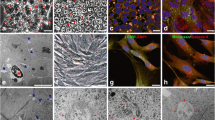Abstract
Previous study demonstrated that the low survival of human embryonic stem cells (hESC) under conventional slow-cooling cryopreservation protocols is predominantly due to apoptosis rather than cellular necrosis. Hence, this study investigated whether a synthetic broad-spectrum irreversible inhibitor of caspase enzymes, Z-VAD-FMK can be used to enhance the post-thaw survival rate of hESC. About 100 mM Z-VAD-FMK was supplemented into either the freezing solution, the post-thaw culture media or both. Intact and adherent hESC colonies were cryopreserved so as to enable subsequent quantitation of the post-thaw cell survival rate through the MTT assay, which can only be performed with adherent cells. Exposure to 100 mM Z-VAD-FMK in the freezing solution alone did not significantly enhance the post-thaw survival rate (10.2% vs. 9.9%, p > 0.05). However, when 100 mM Z-VAD-FMK was added to the post-thaw culture media, there was a significant enhancement in the survival rate from 9.9% to 14.4% (p < 0.05), which was further increased to 18.7% when Z-VAD-FMK was also added to the freezing solution as well (p < 0.01). Spontaneous differentiation of hESC after cryopreservation was assessed by morphological observations under bright-field microscopy, and by immunocytochemical staining for the pluripotency markers SSEA-3 and TRA-1-81. The results demonstrated that exposure to Z-VAD-FMK did not significantly enhance the spontaneous differentiation of hESC within post-thaw culture.


Similar content being viewed by others
References
Aono N, Naganuma T, Abe Y, Hara K, Sasada H, Sato E, Yoshida H (2003) Successful production of blastocysts following ultrarapid vitrification with step-wise equilibriation of germinal vesicle-stage mouse oocytes. J Reprod Dev 49:501–506
Baust JM, Van Buskirk, Baust JG (2000) Cell viability improves following inhibition of cryopreservation-induced apoptosis. In Vitro Cell Dev Biol Anim 36:262–270
Chen D, Lewis RL, Kaufman DS (2003) Mouse and human embryonic stem cell models of hematopoiesis: past, present, and future. Biotechniques 35:1253–1261
Chian RC, Kuwayama M, Tan L, Tan J, Kato O, Nagai T (2004) High survival rate of bovine oocytes matured in vitro following vitrification. J Reprod Dev 50:685–696
Eisenberg LM, Kubalak SW, Eisenberg CA (2004) Stem cells and the formation of the myocardium in the vertebrate embryo. Anat Rec A Discov Mol Cell Evol Biol 276:2–12
Ezashi T, Das P, Roberts RM (2005) Low O2 tensions and the prevention of differentiation of hES cells. Proc Natl Acad Sci USA 102:4783–4788
Garcia-Calvo M, Peterson EP, Leiting B, Ruel R, Nicholson DW, Thornberry NA (1998) Inhibition of human caspases by peptide-based and macromolecular inhibitors. J Biol Chem 273:32608–32613
Gerecht-Nir S, Itskovitz-Eldor J (2004) Cell therapy using human embryonic stem cells. Transpl Immunol 12:203–209
Gribaldo L, Alison M, Andrews PW, Bremer S, Donovan PJ, Knaan-Shanzer S, Mertelsmann R, Spielmann H, Testa NG, Triffitt JT, Zipori D, de Wynter E (2002) Meeting summary: European Workshop on Stem Cells, European Centre for the Validation of Biomedical Testing Methods, Institute for Health and Consumer Protection, Joint Research Centre, Ispra, Italy, November 21–23, 2001. Exp Hematol 30:628–633
Heng BC, Kuleshova LL, Bested SM, Liu H, Cao T (2005) The cryopreservation of human embryonic stem cells. Biotechnol Appl Biochem 41:97–104
Heng BC, Liu H, Rufaihah AJ, Cao T (2006) Human embryonic stem cell (hES) colonies display a higher degree of spontaneous differentiation when passaged at lower densities. In Vitro Cell Dev Biol Anim 42:54–57
Heng BC, Ye CP, Liu H, Toh WS, Rufaihah AJ, Yang Z, Bay BH, Ge Z, Ouyang HW, Lee EH, Cao T (2006) Loss of viability during freeze-thaw of intact and adherent human embryonic stem cells with conventional slow-cooling protocols is predominantly due to apoptosis rather than cellular necrosis. J Biomed Sci 13:433–445
Mosmann T (1983) Rapid colorimetric assay for cellular growth and survival: application to proliferation and cytotoxicity assays. J Immunol Methods 65:55–63
NIH Stem Cell Backgrounder (2003) Available at the following URL address: http://www.nih.gov/news/backgrounders/stemcellbackgrounder.htm Accessed December 31, 2005
Reubinoff BE, Pera MF, Vajta G, Trounson AO (2001) Effective cryopreservation of human embryonic stem cells by the open pulled straw vitrification method. Hum Reprod 16:2187–2194
Richards M, Fong CY, Tan S, Chan WK, Bongso A (2004) An efficient and safe xeno-free cryopreservation method for the storage of human embryonic stem cells. Stem Cells 22:779–789
Rohwedel J, Guan K, Hegert C, Wobus AM (2001) Embryonic stem cells as an in vitro model for mutagenicity, cytotoxicity and embryotoxicity studies: present state and future prospects. Toxicol in Vitro 15:741–753
Schmidt-Mende J, Hellstrom-Lindberg E, Joseph B, Zhivotovsky B (2000) Freezing induces artificial cleavage of apoptosis-related proteins in human bone marrow cells. J Immunol Methods 245:91–94
Slee EA, Zhu H, Chow SC (1996) Benzyloxycarbonyl-Val-Ala-Asp (OMe) fluoromethylketone (Z-VAD.FMK) inhibits apoptosis by blocking the processing of CPP32. Biochem J 315:21–24
Wicell Research Institute Inc. Appendix-Freezing Human Embryonic Stem Cells (2005) Accessible at: http://www.wicell.org/uploads/media/Freezing_Human_ESC_04.pdf. Date accessed: Dec 31, 2005
Author information
Authors and Affiliations
Corresponding author
Rights and permissions
About this article
Cite this article
Heng, B.C., Clement, M.V. & Cao, T. Caspase Inhibitor Z-VAD-FMK Enhances the Freeze-Thaw Survival Rate of Human Embryonic Stem Cells. Biosci Rep 27, 257–264 (2007). https://doi.org/10.1007/s10540-007-9051-2
Published:
Issue Date:
DOI: https://doi.org/10.1007/s10540-007-9051-2




